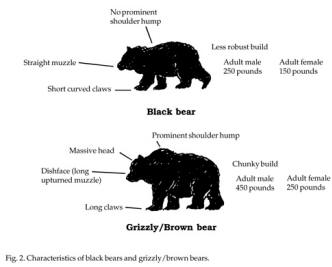The black bear (Ursus americanus, Fig. 1) is the smallest and most widely distributed of the North American bears. Adults typically weigh 100 to 400 pounds (45 to 182 kg) and measure from 4 to 6 feet (120 to 180 cm) long. Some adult males attain weights of over 600 pounds (270 kg). They are massive and strongly built animals. Black bears east of the Mississippi are predominantly black, but in the Rocky Mountains and westward various shades of brown, cinnamon, and even blond are common. The head is moderately sized with a straight profile and tapering nose. The ears are relatively small, rounded, and erect. The tail is short (3 to 6 inches [8 to 15 cm]) and inconspicuous. Each foot has five curved claws about 1 inch (2.5 cm) long that are non-retractable. Bears walk with a shuffling gait, but can be quite agile and quick when necessary. For short distances, they can run up to 35 miles per hour (56 km/hr). They are quite adept at climbing trees and are good swimmers.
It is important to be able to distinguish between black bears and grizzly/ brown bears (Ursus arctos). The grizzly/brown bear is typically much larger than the black bear, ranging from 400 to 1,300 pounds (180 to 585 kg). Its guard hairs have whitish or silvery tips, giving it a frosted or “grizzly†appearance. Grizzly/brown bears have a pronounced hump over the shoulder; a shortened, often dished face; relatively small ears; and long claws (Fig. 2).
